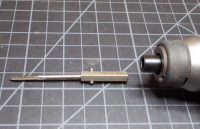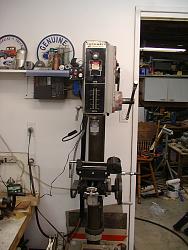I've never tapped anything under power. No matter how much you laud tapping heads, there's just no way I'm going to trust one to tap 0-80 into a model engine part I've spent eight hours making.
But never say no. I had the task of tapping a bunch of non-critical 6-32 holes in some 2" plastic pipe. It occurred to me that this would be the ideal job to try my hand at power tapping. An electric drill is way too fast but an electric screwdriver might just be the ticket. It's slow and stops pretty much instantaneously when you release the trigger plus it's easy to reverse to back the tap out. 6-32 is the weakest common inferial thread but plastic is a pretty forgiving medium so it's worth a try.
I made a simple chuck to interface the tap to the screwdriver...
Most taps from #6 downwards have the same size shank so by drilling a #28 (0.1405) hole, the chuck will serve for most small taps. The body is a piece of 1/4" steel hex and the tap is held in place by 6-32 setscrews which bear on the square end of the shank.
It worked very well. I'll consider power tapping again if the stock is soft and the part non-critical. For stuff with a big time investment, I'll stick with guided hand-tapping.


 LinkBack URL
LinkBack URL About LinkBacks
About LinkBacks



 Reply With Quote
Reply With Quote







Bookmarks